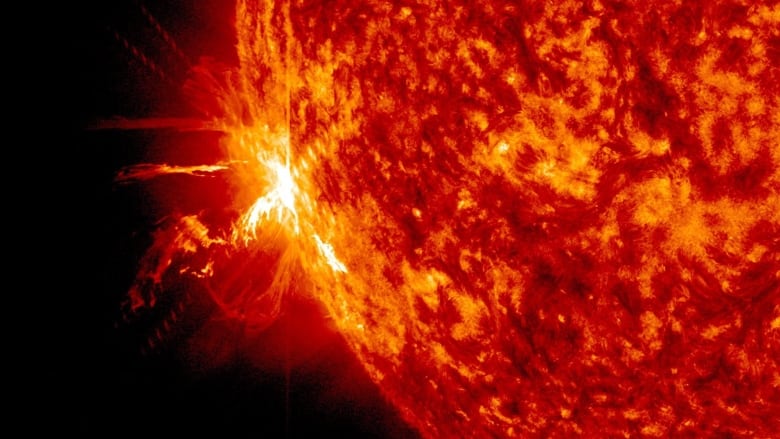Solar storms, a cause of northern lights, nearly led to nuclear war in 1967
Academic uncovers incident when solar radiation jammed radar stations meant to detect Soviet missiles

A new research paper says a 1967solar stormon the sun, which can cause a spectacularnorthern lights show, nearly led toa nuclear war at the height of the Cold War.
As tensions mounted between NATO and the Soviet Union throughout the 1950s and 1960s, a series of early warning or radar systemswere set up. First came the DEW (Distant Early Warning)-Line sites, strung across the Arctic.
-
FROM THE ARCHIVES |The DEW Line's toxic legacy
In 1967, as the arms race intensified and the threat of intercontinental ballistic missiles arrived, three new radar stations the Ballistic Missile Early Warning System (BMEWS)began operating in Alaska, Greenland, and the U.K. to protect against the threat of a Soviet attack.

But 10 days after they began working, they suddenlystopped.
"All of them reported signals that had every signature of jamming," says Dr. Delores Knipp, who wrote about this story ina recently published article in the journalSpace Weather.
The signals were blocked, rendering the new radar stations useless, essentially blinding the West from any pertinent threats from the Soviet Union.
And that was considered an act of war.
NORAD feared this marked the prelude to an attack, so fighter pilots scrambled, and the world was just minutes away from awar between nuclear powers.
But thanks to a unit of "space weathermen" that was just barely established, an act of war was averted and NORAD realized the value of monitoring the sun's weather.
A story 'that was begging to be told'
Knipp worked for NORAD as a weather briefer for 22 years, and while she was there she would occasionally hear mention of "an event" that had occurred in the 1960s. The information was classified, and she wasn't cleared to access it.

Last October, at a conference in Washington, D.C., that "event" resurfaced through tributes to a commander who had recently died. She decided to look at the tributes online.
With more digging into since-declassified records and reports, the story began to be revealed.
"Maybe in another life I would be a crime-scene investigator," she says. "It was a story that was begging to be told."
The Great Storm
The sun is subject toweather just like Earth, but storms on the sun can affect the entire solar system, sending out bursts of electromagnetic radiation and ionizing particles that can disrupt satellites, wreak havoc on electrical gridsand jam radios.
Solar storms also are often the cause of coronal mass ejections, or CMEs, which show up on Earth in the form of the northern lights.
Within roughly eight minutes of a solar storm, the first radiation slams into our atmosphere, interfering with anything that depends on radio signals, such as radar systems.
"That can start within 20 minutes and go on for days," says Knipp.

"That number is typically 100, and during the peak of a solar cycle it could be 300," says Knapp. "That day it was 8,000."
The solar flare that knocked out the radar stations in 1967 is known as one of the "great storms" of the 20th century, with the northern lights swirling in the sky as far south as New Mexico.
Space weathermen
Although the sun's weather has been noted as far back as 1182 with the first-recorded observation of a sunspot, the modern practice of monitoring the sun's radiation with radio-telescopes didn't begin until the 1940s.A new unit of scientists had just begun working at the Cheyenne Mountain NORAD complex the year before the Great Storm that caused the radar outages.
- FROM THE ARCHIVES |Norad is 'a monument to the Cold War,' says historian
"It was only maybe five years earlier that the program for training these officers had been conceived," Knipp says.
As the radar stations shut down, the defence of the Western world lay in the hands of commanders who did not have access to solar forecasts. The Strategic Air Command did not have trained forecasters on staff.In fact, NORAD was the only unit with "space weathermen" on staff.
"That changed very rapidly after this event," says Knipp.
Fortunately, given the high stakes, NORAD was part of the decision-making loop. It wasn't until word reached Strategic Air Command that it was solar flares and not a Soviet attack that was jamming the radar stations that the fighter planes were taken off the runway.
"You look at it and you go, well, everything did work," Knipp says. "In the end, we had the right people with the right education at the right time to say, 'Let's take another look at this.'"
Solar flares still interfere with technology
The danger of nuclear annihilation due to a solar flare may be past, but the sun's chaotic weather remains a risk to modern life on Earth.

Although steps have been taken to prevent that kind of situation from happening again, solar storms and their associated bursts of energy still present a complicated problem for communications and satellites.
"Our modelling is still rudimentary," says Knipp. "We still don't predict them. We know about them when the photons arrive."
When the photons arrive, they still bring with them disruptions to high-frequency radios, GPS, and other basic communications tools. Knipp says people relying on high-frequency radios when a flare hits Earth "just have to deal with it."
- FROM THE ARCHIVES |Studying the northern lights
CMEs, the slower-moving balls of particles that often follow solar flares, can knock out unprepared power grids for weeks or months. With current monitoring, we only get about an hour of warning before they strike.
"The fastest CMEs could pass that satellite and be impacting Earth's magnetic field within 30 minutes. And of course it's the fast ones that cause the grief," says Knipp.
"Power grids need more time than that."












_(720p).jpg)


 OFFICIAL HD MUSIC VIDEO.jpg)
.jpg)



























































































